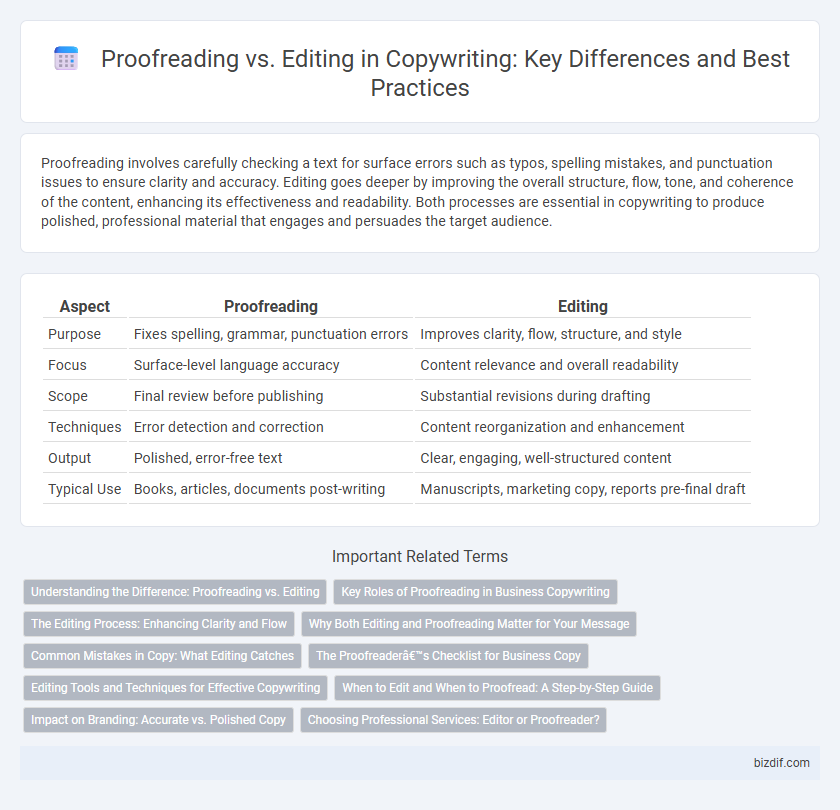Proofreading involves carefully checking a text for surface errors such as typos, spelling mistakes, and punctuation issues to ensure clarity and accuracy. Editing goes deeper by improving the overall structure, flow, tone, and coherence of the content, enhancing its effectiveness and readability. Both processes are essential in copywriting to produce polished, professional material that engages and persuades the target audience.
Table of Comparison
| Aspect | Proofreading | Editing |
|---|---|---|
| Purpose | Fixes spelling, grammar, punctuation errors | Improves clarity, flow, structure, and style |
| Focus | Surface-level language accuracy | Content relevance and overall readability |
| Scope | Final review before publishing | Substantial revisions during drafting |
| Techniques | Error detection and correction | Content reorganization and enhancement |
| Output | Polished, error-free text | Clear, engaging, well-structured content |
| Typical Use | Books, articles, documents post-writing | Manuscripts, marketing copy, reports pre-final draft |
Understanding the Difference: Proofreading vs. Editing
Proofreading involves carefully checking text for surface errors such as spelling, grammar, punctuation, and typographical mistakes, ensuring the final content is polished and error-free. Editing goes deeper by improving the overall structure, clarity, coherence, and tone, often requiring content reorganization and rewriting to enhance readability and effectiveness. Understanding the difference between proofreading and editing is essential for creating high-quality copy that communicates the intended message clearly and professionally.
Key Roles of Proofreading in Business Copywriting
Proofreading in business copywriting ensures error-free content by identifying typos, grammatical mistakes, and formatting inconsistencies, which enhances readability and professionalism. It safeguards brand reputation through precise language and accurate messaging, preventing misunderstandings and credibility loss. Effective proofreading improves conversion rates by delivering polished copy that instills customer confidence and drives engagement.
The Editing Process: Enhancing Clarity and Flow
The editing process involves refining a text to improve clarity, coherence, and overall flow by restructuring sentences, eliminating redundancies, and enhancing word choice. Editors focus on the logical progression of ideas and tightening the narrative to ensure the message resonates effectively with the target audience. This stage surpasses basic grammar checks, prioritizing stylistic consistency and readability to elevate the quality of the copy.
Why Both Editing and Proofreading Matter for Your Message
Editing enhances clarity, coherence, and flow by restructuring sentences and refining word choice, ensuring your message is compelling and engaging. Proofreading catches grammatical, spelling, and punctuation errors that could undermine professionalism and distract readers. Combining both processes guarantees your content is polished, credible, and effectively communicates your intended message.
Common Mistakes in Copy: What Editing Catches
Editing catches common copywriting mistakes such as inconsistent tone, unclear messaging, and awkward sentence structure that proofreading often overlooks. It ensures logical flow, clarity, and alignment with brand voice, improving overall readability and engagement. Thorough editing eliminates redundancy and sharpens arguments, enhancing the impact of marketing content.
The Proofreader’s Checklist for Business Copy
The proofreader's checklist for business copy includes verifying grammar, punctuation, and spelling accuracy to ensure clarity and professionalism. It involves checking consistency in formatting, font usage, and adherence to brand guidelines to maintain a cohesive corporate image. Attention to detail in verifying facts, figures, and contact information is essential to prevent costly errors and uphold credibility.
Editing Tools and Techniques for Effective Copywriting
Editing tools like Grammarly, Hemingway Editor, and ProWritingAid enhance copywriting by identifying grammar issues, improving sentence structure, and optimizing readability. Effective editing techniques involve tightening language, clarifying messaging, and ensuring consistency in tone and style to engage the target audience. Integrating AI-powered editing tools with manual review boosts accuracy and refines the overall impact of marketing copy.
When to Edit and When to Proofread: A Step-by-Step Guide
Editing is essential during the revision stage to enhance clarity, coherence, and overall content quality by restructuring sentences and refining ideas. Proofreading comes as the final step, targeting surface errors such as typos, grammar mistakes, and punctuation before publication. Following this sequence ensures polished, error-free copy that effectively communicates its message.
Impact on Branding: Accurate vs. Polished Copy
Proofreading ensures accurate copy by eliminating spelling, grammar, and punctuation errors that maintain the brand's credibility and trustworthiness. Editing enhances polished copy by refining tone, style, and coherence to better align with brand voice and audience expectations. Both processes are essential for delivering a professional and impactful brand message that resonates with customers.
Choosing Professional Services: Editor or Proofreader?
Choosing between an editor and a proofreader depends on the stage and scope of your content refinement needs. Editors focus on enhancing structure, clarity, tone, and overall flow, while proofreaders specialize in catching grammatical, spelling, and typographical errors. Hiring a professional editor is ideal for comprehensive content improvement, whereas a proofreader ensures polished, error-free final drafts.
Proofreading vs Editing Infographic

 bizdif.com
bizdif.com